A Non Intrusive Human Presence Detection Methodology Based on Channel State Information of Wi-Fi Networks
Abstract
1. Introduction
- CSI is used instead of RSSI because it provides more detailed physical layer information and can be used for location and tracking services with higher accuracy.
- Exploiting the information of the subcarriers amplitude provided by CSI and a feature extraction our approach is able to detect human presence in different environments.
- Only Wi-Fi networks are employed to detect human presence, and no additional hardware is needed.
- Classifiers evaluation is carried out, such as Support Vector Machine (SVM), decision trees and K-nearest neighbors (KNN) in order to detect which one can return a more accurate system.
2. Related Work
3. Channel State Information
4. Methodology
- First data are collected at every location previously defined from an IEEE 802.11 access point. CSI information specifies the amplitude and phase of the signal path between a single transmitter–receiver antenna pair.
- In the next step, CSI amplitude processing, where CSI is processed to extract subcarriers amplitude for the transmission. After that, these signals are filtered to achieve better results with a low-pass filter implemented with a MATLAB function.
- Next, the dataset is built with these vectors feature extraction.
- In addition, finally, they are used as an input of the machine learning algorithm to create the different models.
4.1. Data Collection
4.2. CSI Amplitude Processing
4.3. Signal Filtering
4.4. Features Extraction
- Max Mean: gives the maximum value of the mean in the sample of amplitude information;
- Max RMS: gives the maximum value of the root mean square in the sample;
- NumberOfChanges: show the number of abrupt changes in the signal;
- Max STD: gives the maximum value of the standard deviation in the signal.
4.5. Classification
5. Datasets
5.1. Scenario 1
5.2. Scenario 2
5.3. Both Scenarios
6. Results and Discussion
6.1. Scenario 1
6.2. Scenario 2
6.3. Both Scenarios
6.4. Performance Evaluation
7. Conclusions and Future Work
Author Contributions
Funding
Institutional Review Board Statement
Informed Consent Statement
Data Availability Statement
Conflicts of Interest
Abbreviations
| BLE | Bluetooth Low Energy |
| CFR | Channel Frequency Response |
| CSI | Channel State Information |
| FMID | Fine-Grained Indoor Motion Detection |
| IEEE | Institute of Electrical and Electronics Engineers |
| KNN | K-Nearest Neighbors |
| MIMO | Multiple Input Multiple Output |
| NIC | Network Interface Card |
| OFDM | Orthogonal Frequency Division Multiplexing |
| PIR | Passive Infrared |
| RFID | Radio Frequency Identification |
| RMS | Root Mean Square |
| RSS | Received signal strength |
| RSSI | Received Signal Strength Indicator |
| Rx | Receiver |
| STD | Standard Deviation |
| SVM | Support-Vector Machines |
| Tx | Transmitter |
References
- Nayak, R.; Behera, M.M.; Pati, U.C.; Das, S.K. Video-based Real-time Intrusion Detection System using Deep-Learning for Smart City Applications. In Proceedings of the 2019 IEEE International Conference on Advanced Networks and Telecommunications Systems (ANTS), Goa, India, 16–19 December 2019; pp. 1–6. [Google Scholar] [CrossRef]
- Fortin-Simard, D.; Bilodeau, J.S.; Bouchard, K.; Gaboury, S.; Bouchard, B.; Bouzouane, A. Exploiting Passive RFID Technology for Activity Recognition in Smart Homes. IEEE Intell. Syst. 2015, 30, 7–15. [Google Scholar] [CrossRef]
- Zhiming, W.; Li, Z.; Hong, B. Bi-channel Video Fusion Human Invasion Detection Based on Neural Network. Comput. Eng. 2012, 38, 63645549. [Google Scholar]
- Hu, J.; Zhao, Y.; Zhang, X. Application of Transfer Learning in Infrared Pedestrian Detection. In Proceedings of the 2020 IEEE 5th International Conference on Image, Vision and Computing (ICIVC), Beijing, China, 10–12 July 2020; pp. 1–4. [Google Scholar] [CrossRef]
- Filippoupolitis, A.; Oliff, W.; Loukas, G. Occupancy Detection for Building Emergency Management Using BLE Beacons. In Proceedings of the Computer and Information Sciences; Czachórski, T., Gelenbe, E., Grochla, K., Lent, R., Eds.; Springer International Publishing: Cham, Switzerland, 2016; pp. 233–240. [Google Scholar]
- Tekler, Z.D.; Low, R.; Gunay, B.; Andersen, R.K.; Blessing, L. A scalable Bluetooth Low Energy approach to identify occupancy patterns and profiles in office spaces. Build. Environ. 2020, 171, 106681. [Google Scholar] [CrossRef]
- Huang, K.; He, K.; Du, X. A Hybrid Method to Improve the BLE-Based Indoor Positioning in a Dense Bluetooth Environment. Sensors 2019, 19, 424. [Google Scholar] [CrossRef] [PubMed]
- Tekler, Z.; Low, R.; Yuen, C.; Blessing, L. Plug-Mate: An IoT-based occupancy-driven plug load management system in smart buildings. Build. Environ. 2022, 223, 109472. [Google Scholar] [CrossRef]
- Balaji, B.; Xu, J.; Nwokafor, A.; Gupta, R.; Agarwal, Y. Sentinel: Occupancy based HVAC actuation using existing WiFi infrastructure within commercial buildings. In Proceedings of the 11th ACM Conference on Embedded Networked Sensor Systems, Roma Italy, 11–15 November 2013. [Google Scholar] [CrossRef]
- Tekler, Z.D.; Chong, A. Occupancy prediction using deep learning approaches across multiple space types: A minimum sensing strategy. Build. Environ. 2022, 226, 109689. [Google Scholar] [CrossRef]
- Wang, X.; Yi, P. Security Framework for Wireless Communications in Smart Distribution Grid. IEEE Trans. Smart Grid 2011, 2, 809–818. [Google Scholar] [CrossRef]
- Patwari, N.; Brewer, L.; Tate, Q.; Kaltiokallio, O.; Bocca, M. Breathfinding: A Wireless Network That Monitors and Locates Breathing in a Home. IEEE J. Sel. Top. Signal Process. 2014, 8, 30–42. [Google Scholar] [CrossRef]
- Hsieh, C.H.; Chen, J.Y.; Nien, B.H. Deep Learning-Based Indoor Localization Using Received Signal Strength and Channel State Information. IEEE Access 2019, 7, 33256–33267. [Google Scholar] [CrossRef]
- Chang, R.Y.; Liu, S.J.; Cheng, Y.K. Device-Free Indoor Localization Using Wi-Fi Channel State Information for Internet of Things. In Proceedings of the 2018 IEEE Global Communications Conference (GLOBECOM), Abu Dhabi, United Arab Emirates, 9–13 December 2018; pp. 1–7. [Google Scholar] [CrossRef]
- Liu, A.; Cheng, L.; Yu, C. SASMOTE: A Self-Attention Oversampling Method for Imbalanced CSI Fingerprints in Indoor Positioning Systems. Sensors 2022, 22, 5677. [Google Scholar] [CrossRef] [PubMed]
- Li, H.; Yang, W.; Wang, J.; Xu, Y.; Huang, L. WiFinger: Talk to your smart devices with finger-grained gesture. In Proceedings of the 2016 ACM International Joint Conference on Pervasive and Ubiquitous Computing, Heidelberg, Germany, 12–16 September 2016. [Google Scholar] [CrossRef]
- Yang, J.; Zou, H.; Zhou, Y.; Xie, L. Learning Gestures From WiFi: A Siamese Recurrent Convolutional Architecture. IEEE Internet Things J. 2019, 6, 10763–10772. [Google Scholar] [CrossRef]
- Yadav, S.K.; Sai, S.; Gundewar, A.; Rathore, H.; Tiwari, K.; Pandey, H.M.; Mathur, M. CSITime: Privacy-preserving human activity recognition using WiFi channel state information. Neural Netw. 2022, 146, 11–21. [Google Scholar] [CrossRef] [PubMed]
- Bokhari, S.M.; Sohaib, S.; Khan, A.R.; Shafi, M.; ur Rehman Khan, A. DGRU based human activity recognition using channel state information. Measurement 2021, 167, 108245. [Google Scholar] [CrossRef]
- Wang, W.; Liu, A.X.; Shahzad, M. Gait Recognition Using Wifi Signals. In Proceedings of the 2016 ACM International Joint Conference on Pervasive and Ubiquitous Computing, UbiComp’16, Heidelberg, Germany, 12–16 September 2016; Association for Computing Machinery: New York, NY, USA, 2016; pp. 363–373. [Google Scholar] [CrossRef]
- Tian, Z.; Li, Y.; Zhou, M.; Li, Z. WiFi-Based Adaptive Indoor Passive Intrusion Detection. In Proceedings of the 2018 IEEE 23rd International Conference on Digital Signal Processing (DSP), Shanghai, China, 19–21 November 2018; pp. 1–5. [Google Scholar] [CrossRef]
- Wang, Y.; Wu, K.; Ni, L.M. WiFall: Device-Free Fall Detection by Wireless Networks. IEEE Trans. Mob. Comput. 2017, 16, 581–594. [Google Scholar] [CrossRef]
- Wang, H.; Zhang, D.; Wang, Y.; Ma, J.; Wang, Y.; Li, S. RT-Fall: A Real-Time and Contactless Fall Detection System with Commodity WiFi Devices. IEEE Trans. Mob. Comput. 2017, 16, 511–526. [Google Scholar] [CrossRef]
- Xiao, J.; Wu, K.; Yi, Y.; Wang, L.; Ni, L.M. FIMD: Fine-grained Device-free Motion Detection. In Proceedings of the 2012 IEEE 18th International Conference on Parallel and Distributed Systems, Singapore, 17–19 December 2012; pp. 229–235. [Google Scholar] [CrossRef]
- Forbes, G.; Massie, S.; Craw, S.; Clare, C. Motion Detection using CSI from Raspberry Pi 4. arXiv 2021, arXiv:2111.09091. [Google Scholar]
- Hu, H.; Li, L. A new method using covariance eigenvalues and time window in passive human motion detection based on CSI phases. In Proceedings of the 2017 IEEE 5th International Symposium on Electromagnetic Compatibility (EMC-Beijing), Beijing, China, 28–31 October 2017; pp. 1–6. [Google Scholar] [CrossRef]
- Qian, K.; Wu, C.; Yang, Z.; Liu, Y.; Zhou, Z. PADS: Passive Detection of Moving Targets with Dynamic Speed using PHY Layer Information. In Proceedings of the 20th IEEE International Conference on Parallel and Distributed Systems (ICPADS), Hsinchu, Taiwan, 16–19 December 2014; Volume 2015. [Google Scholar] [CrossRef]
- Chu, F.Y.; Chiu, C.J.; Hsiao, A.H.; Feng, K.T.; Tseng, P.H. WiFi CSI-Based Device-free Multi-room Presence Detection using Conditional Recurrent Network. In Proceedings of the 2021 IEEE 93rd Vehicular Technology Conference (VTC2021-Spring), Helsinki, Finland, 25–28 April 2021; pp. 1–5. [Google Scholar] [CrossRef]
- Wang, J.; Tian, Z.; Zhou, M.; Wang, J.; Yang, X.; Liu, X. Leveraging Hypothesis Testing for CSI Based Passive Human Intrusion Direction Detection. IEEE Trans. Veh. Technol. 2021, 70, 7749–7763. [Google Scholar] [CrossRef]
- Zhou, R.; Lu, X.; Zhao, P.; Chen, J. Device-Free Presence Detection and Localization With SVM and CSI Fingerprinting. IEEE Sens. J. 2017, 17, 7990–7999. [Google Scholar] [CrossRef]
- Tse, D.; Viswanath, P. Fundamentals of Wireless Communication; Wiley Series in Telecommunications; Cambridge University Press: Cambridge, UK, 2005. [Google Scholar]
- Halperin, D.; Hu, W.; Sheth, A.; Wetherall, D. Tool Release: Gathering 802.11n Traces with Channel State Information. SIGCOMM Comput. Commun. Rev. 2011, 41, 53. [Google Scholar] [CrossRef]
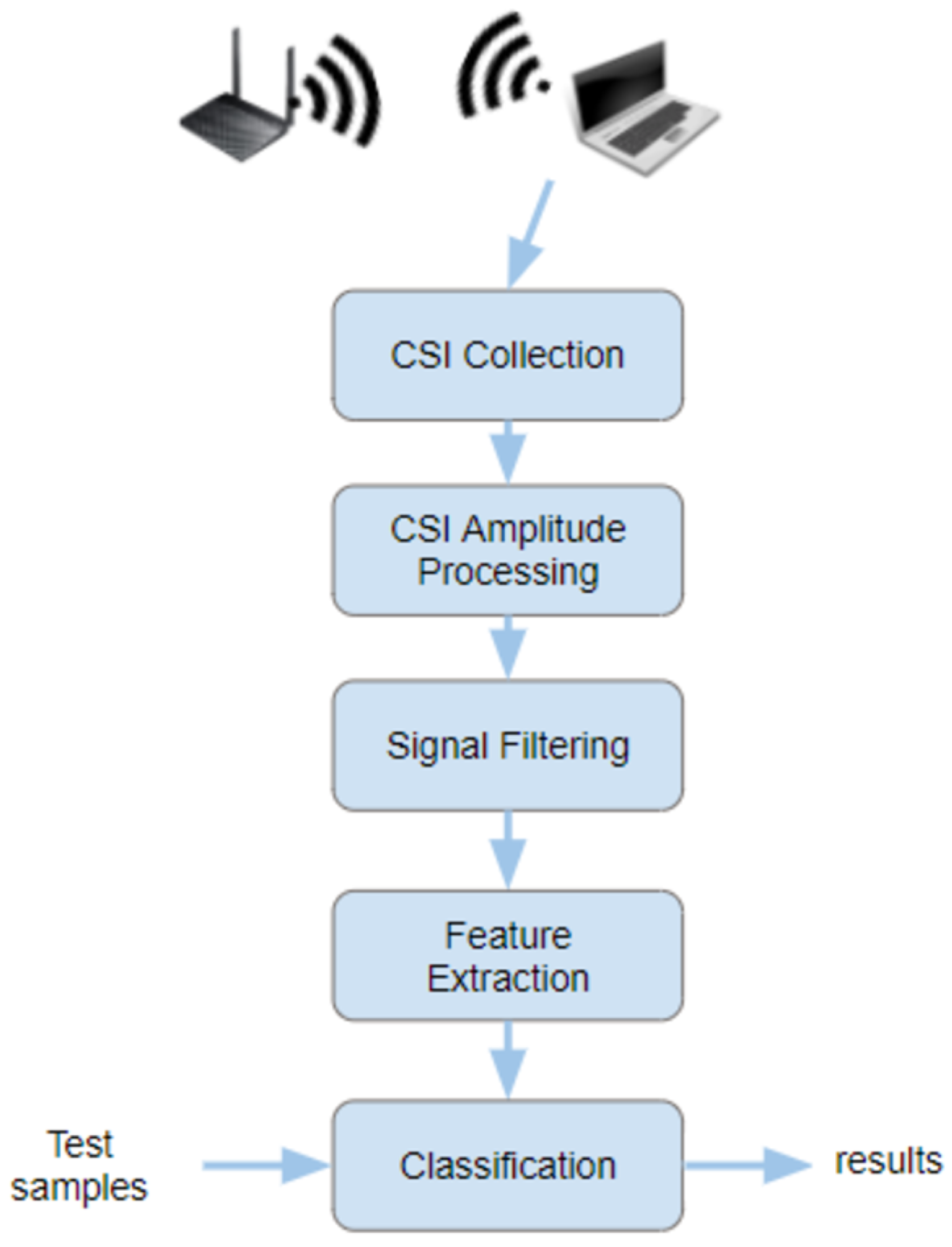
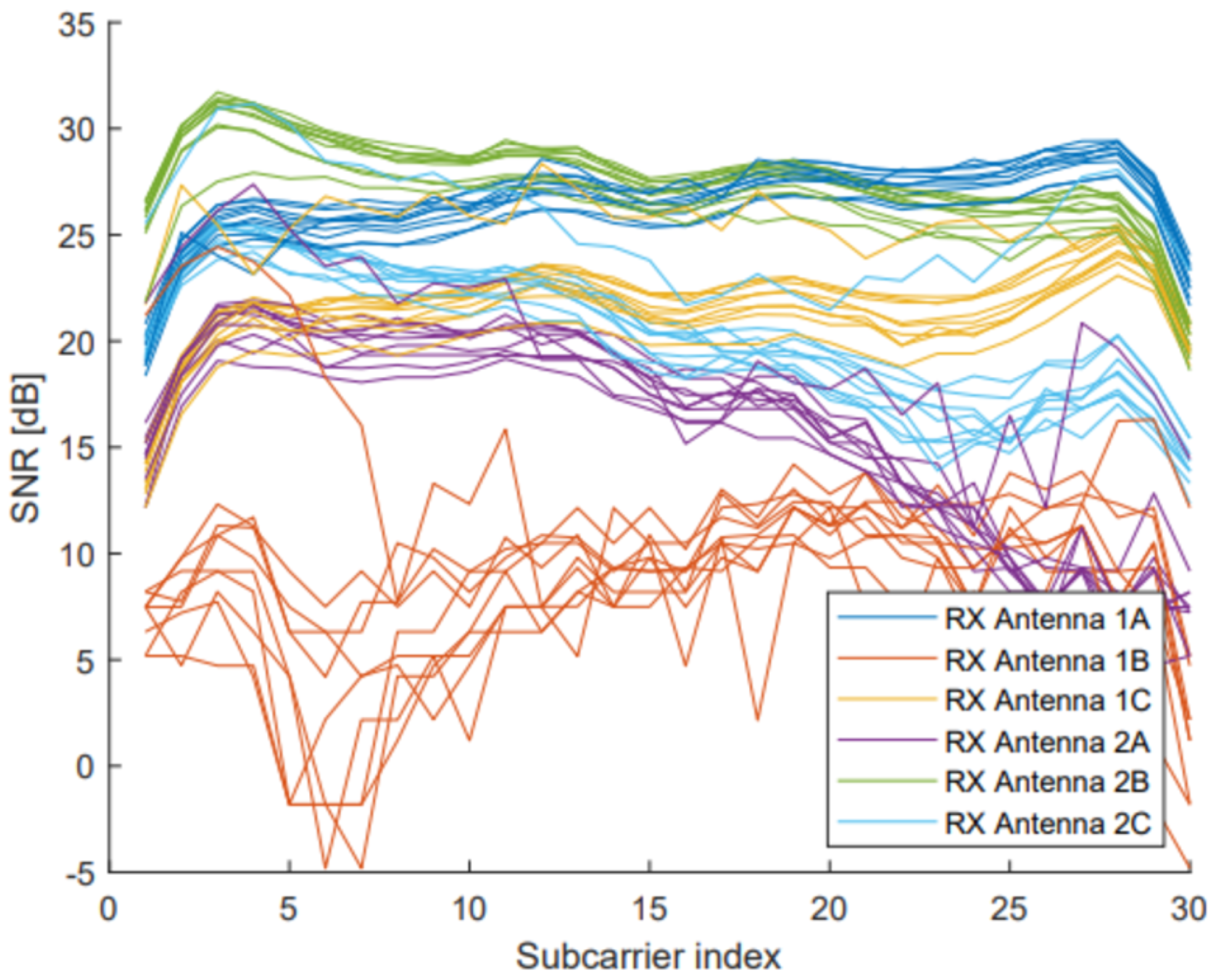
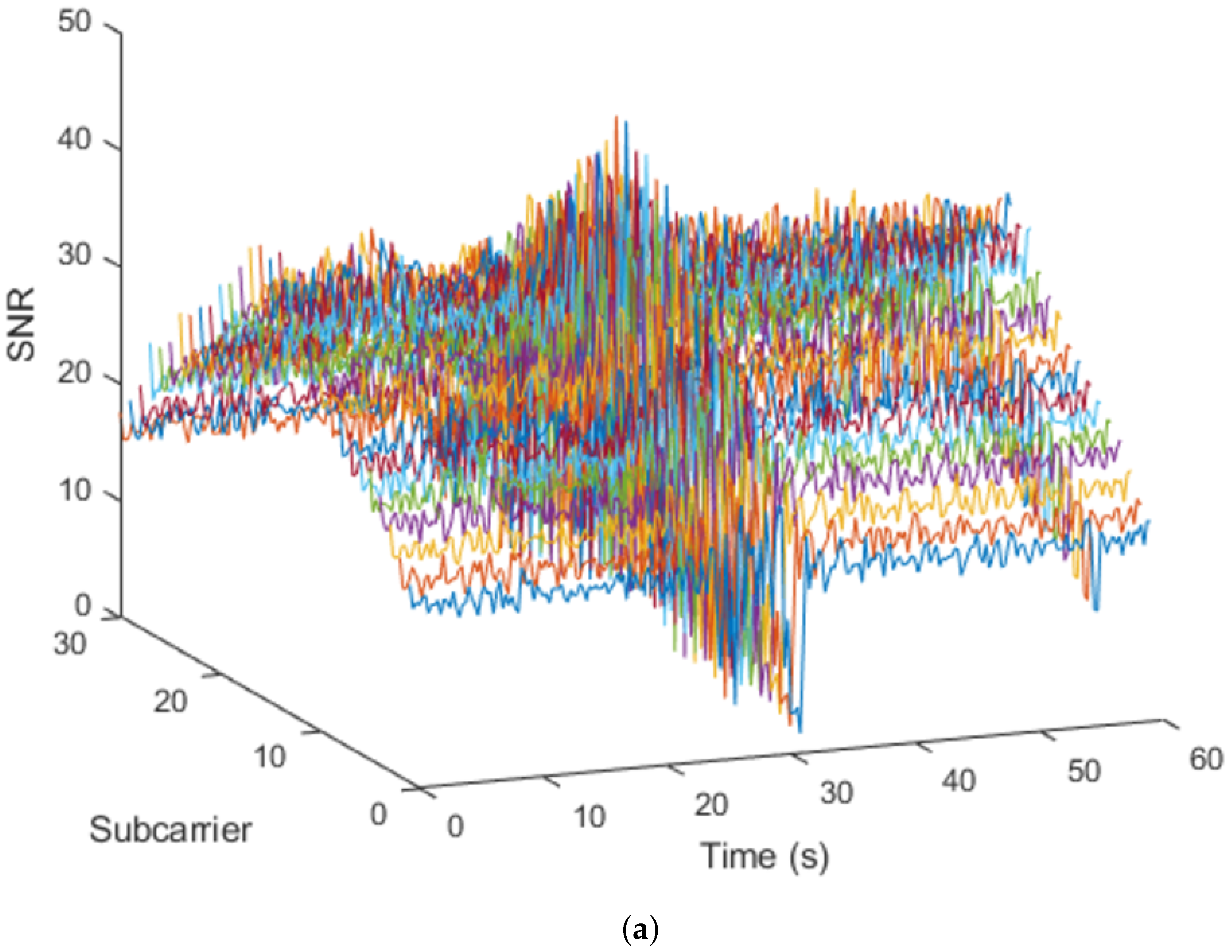
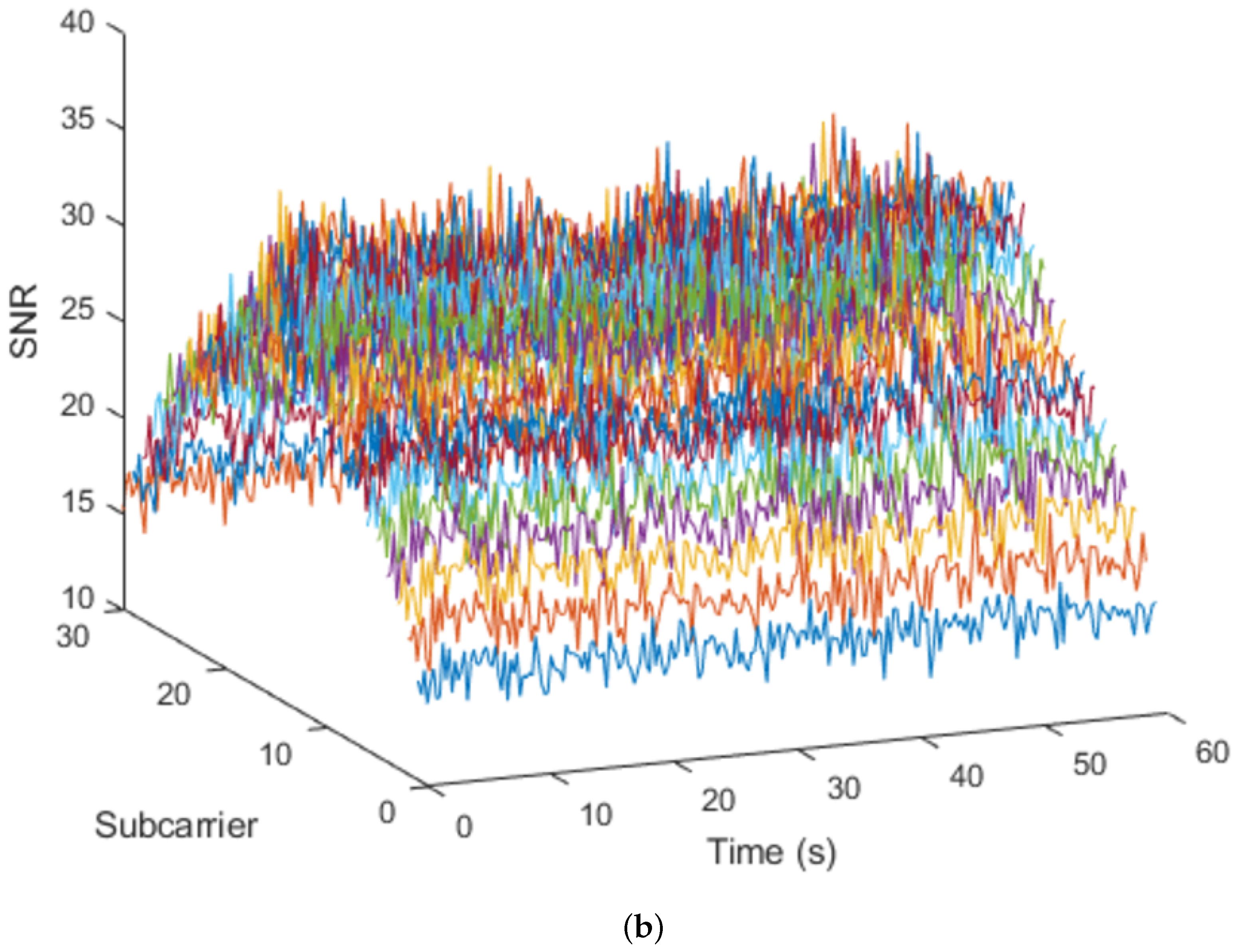
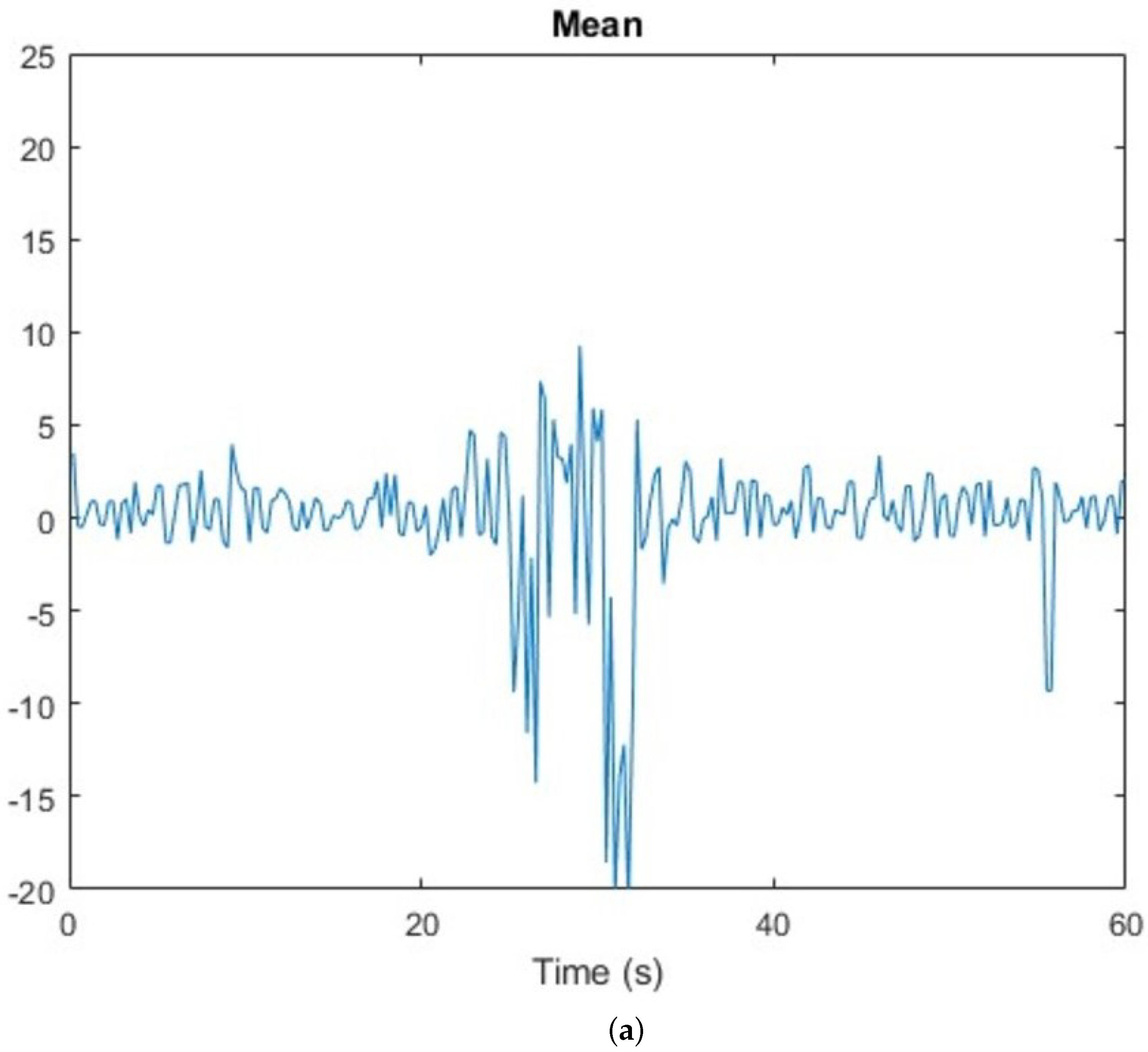
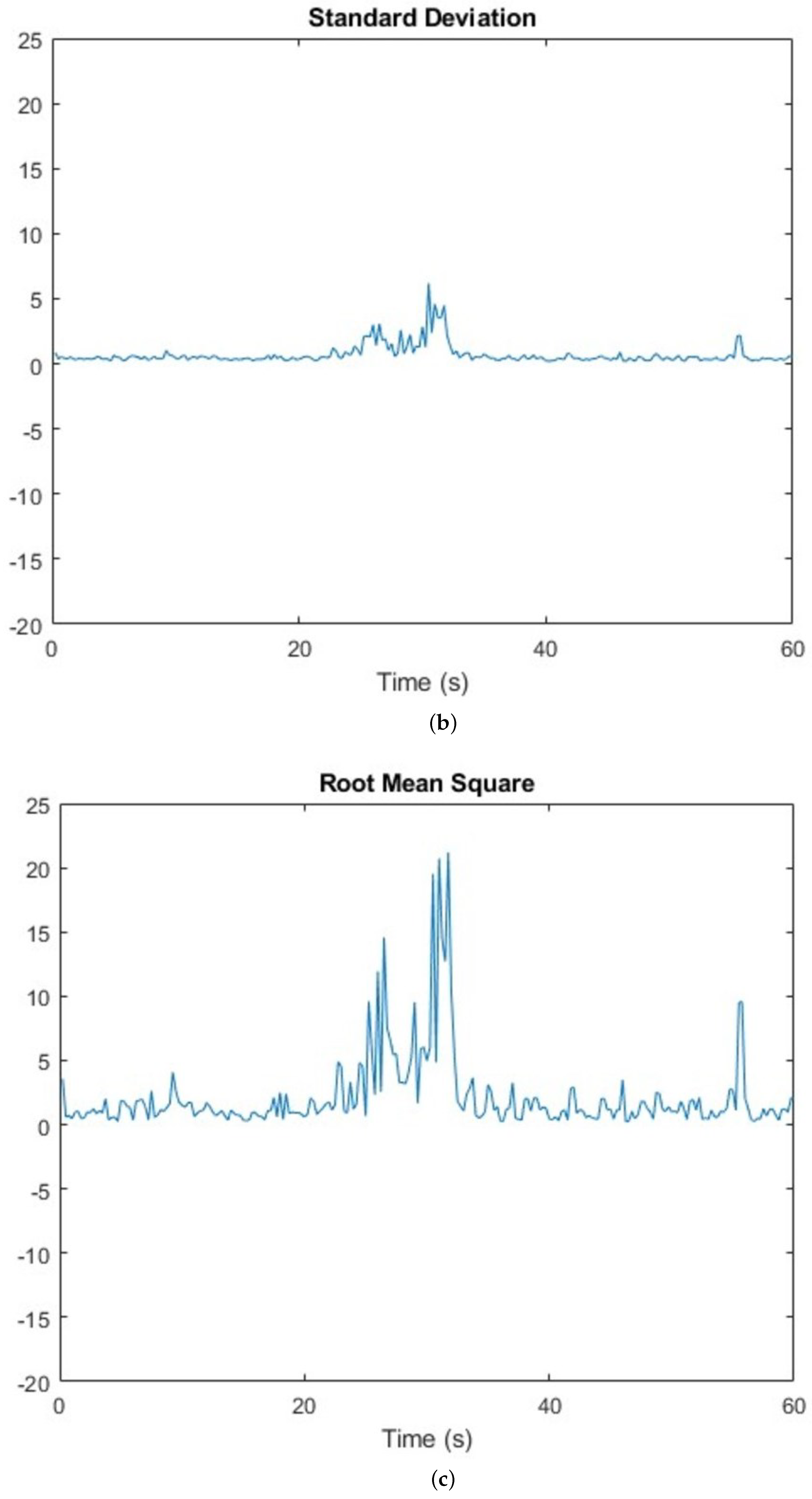
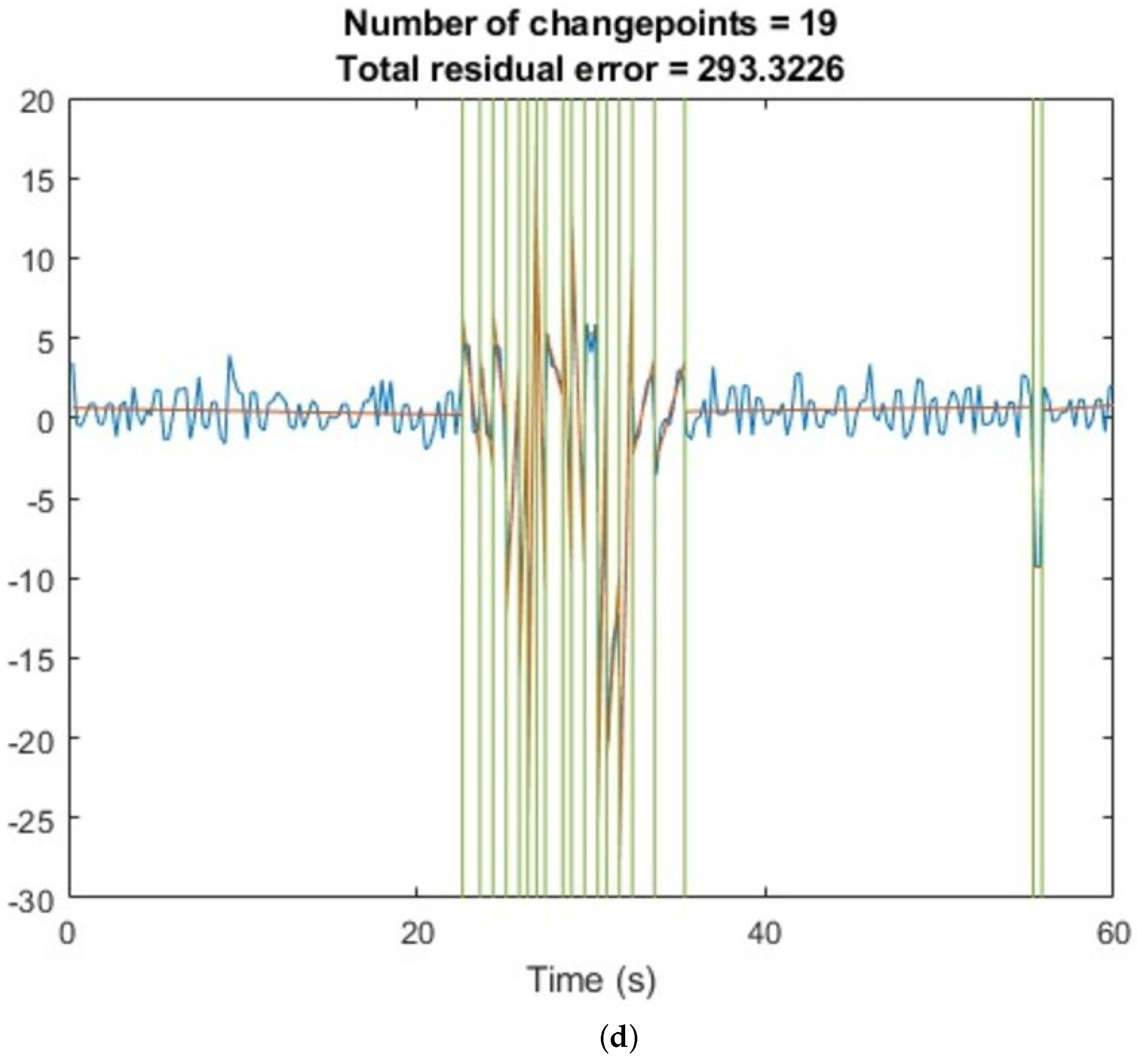
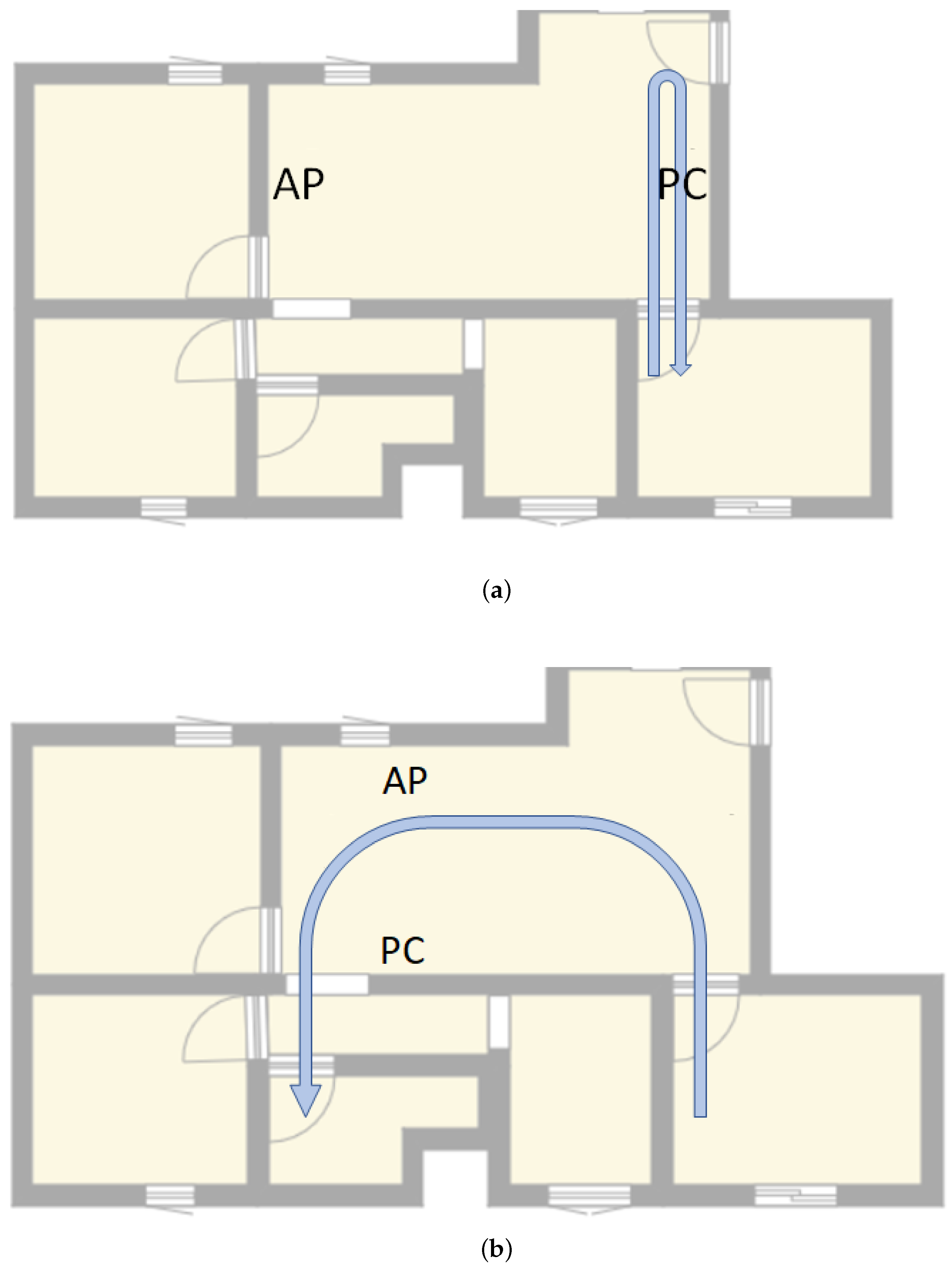
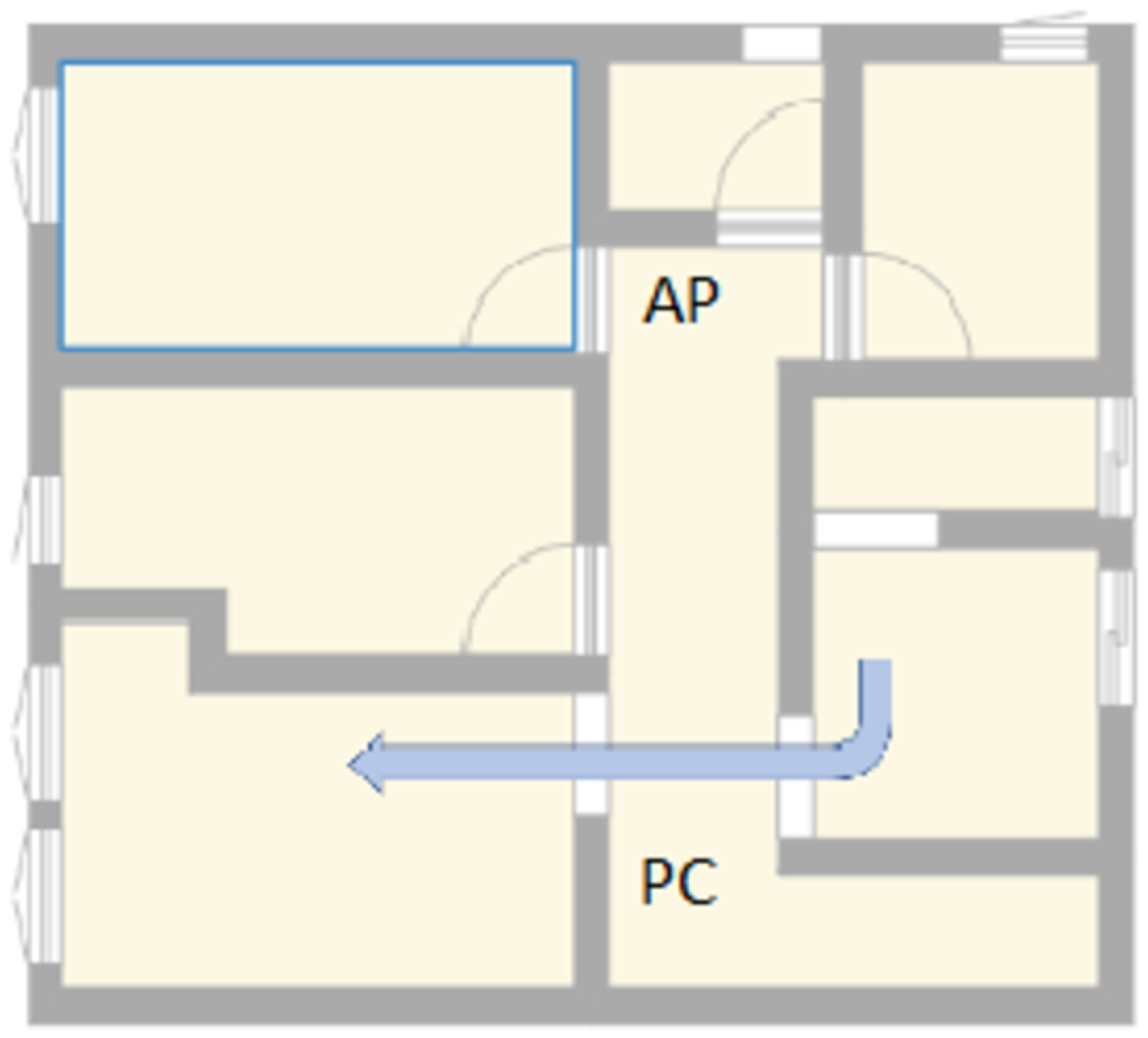
| Max Mean | Max RMS | Number of Changes | Max STD | SIGNAL |
|---|---|---|---|---|
| 9.2722 | 21.1972 | 19 | 6.1864 | ‘Presence’ |
| 3.4004 | 3.5627 | 1 | 1.0912 | ‘No-Presence’ |
| Models | 25% | 50% | 75% |
|---|---|---|---|
| Mean ± STD | Mean ± STD | Mean ± STD | |
| Linear SVM | 89.71 ± 3.76 | 92.4 ± 0 | 92.99 ± 0.58 |
| Quadratic Discrimination | 90.9 ± 0.95 | 90.73 ± 0.6 | 92.7 ± 0.25 |
| Quadratic SVM | 88.49 ± 1.2 | 90.29 ± 1.2 | 91.4 ± 0.84 |
| Models | 25% | 50% | 75% |
|---|---|---|---|
| Mean ± STD | Mean ± STD | Mean ± STD | |
| Linear SVM | 91.67 ± 2.76 | 91.74 ± 0.69 | 93.58 ± 0.57 |
| Quadratic Discrimination | 95.18 ± 1.71 | 92.41 ± 0.83 | 91.05 ± 0.86 |
| Quadratic SVM | 93.08 ± 3.08 | 88.95 ± 1.41 | 91.73 ± 0.86 |
| Models | 25% | 50% | 75% |
|---|---|---|---|
| Mean ± STD | Mean ± STD | Mean ± STD | |
| Linear SVM | 90.35 ± 1.47 | 93.4 ± 0.25 | 93.24 ± 0.31 |
| Quadratic Discrimination | 90.37 ± 0.60 | 93.79 ± 0.37 | 92.36 ± 0.22 |
| Quadratic SVM | 84.2 ± 4.15 | 93.14 ± 0.54 | 92.92 ± 0.45 |
| Models | 25% | 50% | 75% |
|---|---|---|---|
| Mean ± STD | Mean ± STD | Mean ± STD | |
| Scenario 1 | 89.71 ± 3.76 | 92.4 ± 0 | 92.99 ± 0.58 |
| Scenario 2 | 91.67 ± 2.76 | 91.74 ± 0.69 | 93.58 ± 0.57 |
| Both Scenarios | 90.35 ± 1.47 | 93.4 ± 0.25 | 93.24 ± 0.31 |
Disclaimer/Publisher’s Note: The statements, opinions and data contained in all publications are solely those of the individual author(s) and contributor(s) and not of MDPI and/or the editor(s). MDPI and/or the editor(s) disclaim responsibility for any injury to people or property resulting from any ideas, methods, instructions or products referred to in the content. |
© 2023 by the authors. Licensee MDPI, Basel, Switzerland. This article is an open access article distributed under the terms and conditions of the Creative Commons Attribution (CC BY) license (https://creativecommons.org/licenses/by/4.0/).
Share and Cite
Mesa-Cantillo, C.M.; Sánchez-Rodríguez, D.; Alonso-González, I.; Quintana-Suárez, M.A.; Ley-Bosch, C.; Alonso-Hernández, J.B. A Non Intrusive Human Presence Detection Methodology Based on Channel State Information of Wi-Fi Networks. Sensors 2023, 23, 500. https://doi.org/10.3390/s23010500
Mesa-Cantillo CM, Sánchez-Rodríguez D, Alonso-González I, Quintana-Suárez MA, Ley-Bosch C, Alonso-Hernández JB. A Non Intrusive Human Presence Detection Methodology Based on Channel State Information of Wi-Fi Networks. Sensors. 2023; 23(1):500. https://doi.org/10.3390/s23010500
Chicago/Turabian StyleMesa-Cantillo, Carlos M., David Sánchez-Rodríguez, Itziar Alonso-González, Miguel A. Quintana-Suárez, Carlos Ley-Bosch, and Jesús B. Alonso-Hernández. 2023. "A Non Intrusive Human Presence Detection Methodology Based on Channel State Information of Wi-Fi Networks" Sensors 23, no. 1: 500. https://doi.org/10.3390/s23010500
APA StyleMesa-Cantillo, C. M., Sánchez-Rodríguez, D., Alonso-González, I., Quintana-Suárez, M. A., Ley-Bosch, C., & Alonso-Hernández, J. B. (2023). A Non Intrusive Human Presence Detection Methodology Based on Channel State Information of Wi-Fi Networks. Sensors, 23(1), 500. https://doi.org/10.3390/s23010500








